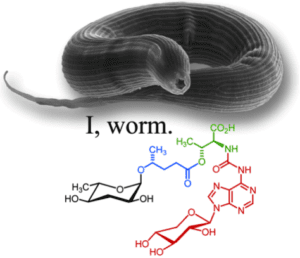News
Worms Hijack RNA Building Blocks, Create Unique Sugar in the Process
 Ithaca, NY – Conventional wisdom holds that genes determine the morphology of animals, but something else may be at play. Frank Schroeder from the Boyce Thompson Institute at Cornell University and Ralf Sommer from the Max-Planck Institute in Germany now report that the roundworm P. pacificus regulates the morphology of its offspring using a potent cocktail of small-molecule signals. Exposure to trace quantities of these chemically unusual molecules can turn genetically identical juveniles into very different types of adults. The paper was published in the December 14th issue ofAngewandte Chemie, DOI: 10.1002/anie.201206797.
Ithaca, NY – Conventional wisdom holds that genes determine the morphology of animals, but something else may be at play. Frank Schroeder from the Boyce Thompson Institute at Cornell University and Ralf Sommer from the Max-Planck Institute in Germany now report that the roundworm P. pacificus regulates the morphology of its offspring using a potent cocktail of small-molecule signals. Exposure to trace quantities of these chemically unusual molecules can turn genetically identical juveniles into very different types of adults. The paper was published in the December 14th issue ofAngewandte Chemie, DOI: 10.1002/anie.201206797.
Schroeder and Sommer investigated the development of the nematode P. pacificus, which can either have a narrow mouth or a wide, large-toothed mouth. The wide mouthed-form had been shown to be associated with low food availability and facilitates a predacious lifestyle: these worms are well equipped to kill and eat other nematodes. Schroeder and Sommer now show that under crowded conditions the worms produce small-molecule signals that trigger development into the wide-mouthed form. These signaling compounds are part of a complex mixture of chemicals that regulates several additional aspects of worm development, including entry into a non-aging larval stage called dauer.
But not only the developmental properties of these worm-derived chemicals are unexpected. ” What fascinated us most were the chemical structures of the compounds we identified—they look like something from a chemistry lab, not like natural products.” Schroeder indicated.
For example, one of the identified signaling molecules is based on an unprecedented type of nucleotide. Nucleotides are crucial components of all living organisms as they form the building blocks of RNA and DNA, and known variations are based exclusively on the furanose form of the sugar ribose. Schroeder and Sommer now showed that P. pacificus produces the previously unknown xylopyranose form of an evolutionarily highly conserved tRNA residue. By combining this xylopyranose-based nucleoside with a lipid-derived side chain and L-paratose, a sugar also not previously found in nature, the worms create a highly potent and specific chemical signal that regulates development of their offspring. Identification of these compounds shows that nematodes can combine building blocks from diverse metabolic pathways into complex chemical architectures. Furthermore, this research suggests that structures of yet unidentified signaling molecules in higher animals, including humans, may deviate significantly from established paradigms, emphasizing the need for a comprehensive investigation of human signaling molecules and their structures.


